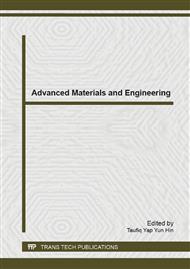[1]
M.F. Mohammed, M.K. Amar, A.R. Siddique, A.H. Said, A review on phase change energy storage: materials and applications, Energy Convers. Manage. 45(2004)1597-1615.
Google Scholar
[2]
K. Murat, M. Khamid, Solar energy storage using phase change materials, Renew. Sust. Energ. Rev. 11(2007) 1913-(1965).
Google Scholar
[3]
A.M. Khudhair, M.M. Farid, A review on energy conservation in building applications with thermal storage by latent heat using phase change materials, Energy Convers. Manage. 45(2004)263-275.
DOI: 10.1016/s0196-8904(03)00131-6
Google Scholar
[4]
M.H. Gtucho, Microcapsules and Microencapsulation Techniques, Noyes Date Corp Press, New York, (1976).
Google Scholar
[5]
C.P. Wang, X.J. Liu, I. Ohnuma, R. Kainuma, K. Ishida, Formation of immiscible alloy powders with egg-type microstructure, Science 297(2002)990-993.
DOI: 10.1126/science.1073050
Google Scholar
[6]
B.Q. Ma, J.Q. Li, Z.J. Peng, G.C. Zhang, Structural morphologies of Cu-Sn-Bi immiscible alloys with varied compositions, J. Alloys Compd. 535 (2012) 95-101.
DOI: 10.1016/j.jallcom.2012.04.032
Google Scholar
[7]
Z. Belen, M. Jose, F.C. Luisa, M. Harald, Review on thermal energy storage with phase change: materials, heat transfer analysis and applications, Appl. Therm. Eng. 23(2003) 251-283.
Google Scholar
[8]
M.K. Murat, High-temperature phase change materials for thermal energy storage, Renew. Sust. Energ. Rev. 14 (2010) 955-970.
Google Scholar
[9]
Y. Li, W. Dong, Y. F. Fu, Y. Tan, A. Miura, A. Kawasaki, The critical cooling rate of Fe-based mono-sized spherical particles with fully glassy phase, Adv. Mater. Res. 509(2012)185-191.
DOI: 10.4028/www.scientific.net/amr.509.185
Google Scholar
[10]
A.H. Ayyad, W. Freyland, Wetting transition in liquid Ga–Bi alloys: light scattering study of surface energy and entropy, Surf. Sci. 506(2002)1-11.
DOI: 10.1016/s0039-6028(02)01439-5
Google Scholar
[11]
T. Qin, H.P. Wang, B.B. Wei, Simulated evolution process of core-shell microstructures, Sci. China. Ser. G 50(2007)546-552.
DOI: 10.1007/s11433-007-0045-7
Google Scholar
[12]
R.P. Shi, C.P. Wang, D. Wheeler, X.J. Liu, Y. Wang, Formation mechanisms of self-organized core/shell and core/shell/corona microstructures in liquid droplets of immiscible alloys, Acta Mater. 61 (2013) 1229-1243.
DOI: 10.1016/j.actamat.2012.10.033
Google Scholar
[13]
Information on http: /www. factsage. cn/fact/phase diagram.
Google Scholar


